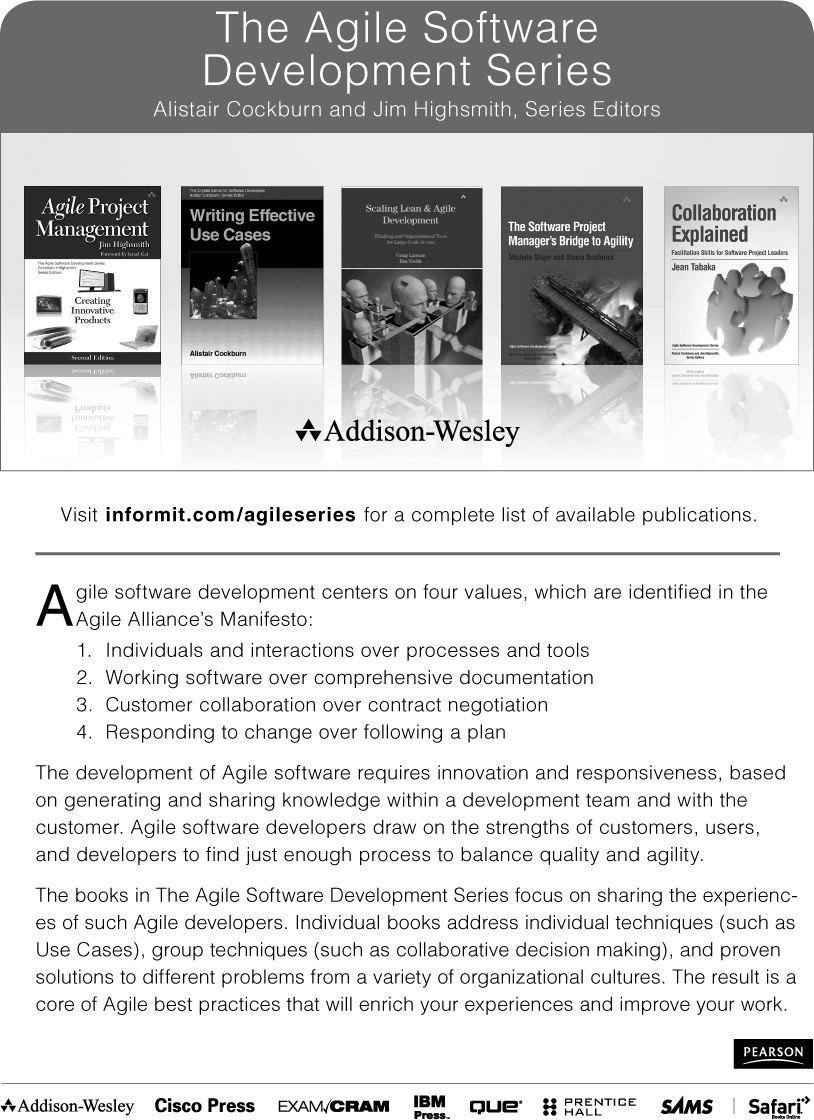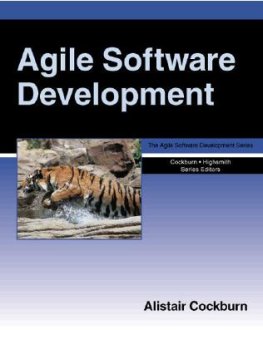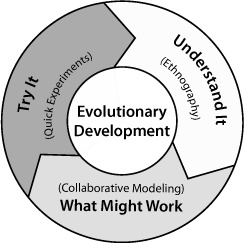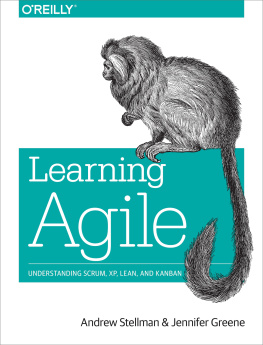Poppendieck Mary.Poppendieck Tom. - Lean software development: an agile toolkit
Here you can read online Poppendieck Mary.Poppendieck Tom. - Lean software development: an agile toolkit full text of the book (entire story) in english for free. Download pdf and epub, get meaning, cover and reviews about this ebook. City: Boston etc, year: 2013;2003, publisher: Pearson Education Limited (US titles);Addison Wesley, genre: Computer. Description of the work, (preface) as well as reviews are available. Best literature library LitArk.com created for fans of good reading and offers a wide selection of genres:
Romance novel
Science fiction
Adventure
Detective
Science
History
Home and family
Prose
Art
Politics
Computer
Non-fiction
Religion
Business
Children
Humor
Choose a favorite category and find really read worthwhile books. Enjoy immersion in the world of imagination, feel the emotions of the characters or learn something new for yourself, make an fascinating discovery.

- Book:Lean software development: an agile toolkit
- Author:
- Publisher:Pearson Education Limited (US titles);Addison Wesley
- Genre:
- Year:2013;2003
- City:Boston etc
- Rating:4 / 5
- Favourites:Add to favourites
- Your mark:
- 80
- 1
- 2
- 3
- 4
- 5
Lean software development: an agile toolkit: summary, description and annotation
We offer to read an annotation, description, summary or preface (depends on what the author of the book "Lean software development: an agile toolkit" wrote himself). If you haven't found the necessary information about the book — write in the comments, we will try to find it.
Lean software development: an agile toolkit — read online for free the complete book (whole text) full work
Below is the text of the book, divided by pages. System saving the place of the last page read, allows you to conveniently read the book "Lean software development: an agile toolkit" online for free, without having to search again every time where you left off. Put a bookmark, and you can go to the page where you finished reading at any time.
Font size:
Interval:
Bookmark:
ePUB is an open, industry-standard format for eBooks. However, support of ePUB and its many features varies across reading devices and applications. Use your device or app settings to customize the presentation to your liking. Settings that you can customize often include font, font size, single or double column, landscape or portrait mode, and figures that you can click or tap to enlarge. For additional information about the settings and features on your reading device or app, visit the device manufacturers Web site.
Many titles include programming code or configuration examples. To optimize the presentation of these elements, view the eBook in single-column, landscape mode and adjust the font size to the smallest setting. In addition to presenting code and configurations in the reflowable text format, we have included images of the code that mimic the presentation found in the print book; therefore, where the reflowable format may compromise the presentation of the code listing, you will see a Click here to view code image link. Click the link to view the print-fidelity code image. To return to the previous page viewed, click the Back button on your device or app.
An Agile Toolkit
Mary Poppendieck
Tom Poppendieck

Boston San Francisco New York Toronto Montreal
London Munich Paris Madrid
Capetown Sydney Tokyo Singapore Mexico City
Many of the designations used by manufacturers and sellers to distinguish their products are claimed as trademarks. Where those designations appear in this book, and Addison-Wesley, Inc. was aware of a trademark claim, the designations have been printed with initial capital letters or in all capitals.
The authors and publisher have taken care in the preparation of this book, but they make no expressed or implied warranty of any kind and assume no responsibility for errors or omissions. No liability is assumed for incidental or consequential damages in connection with or arising out of the use of the information or programs contained herein.
The publisher offers discounts on this book when ordered in quantity for special sales. For more information, please contact:
Pearson Education Corporate Sales Division
One Lake Street
Upper Saddle River, NJ 07458
(800) 382-3419
Visit AW on the Web: www.awl.com/cseng/
Library of Congress Cataloging-in-Publication Data available
Copyright 2003 by Addison-Wesley
All rights reserved. No part of this publication may be reproduced, stored in a retrieval system, or transmitted, in any form, or by any means, electronic, mechanical, photocopying, recording, or otherwise, without the prior consent of the publisher. Printed in the United States of America. Published simultaneously in Canada.
ISBN 0-321-15078-3
Text printed in the United States on recycled paper at RR Donnelley in Crawfordsville, Indiana. Seventeenth printing, May 2013

To Dustin, Andy and Brian, Karen and Becca
BY JIM HIGHSMITH
In February 2001, when Agile was adopted as the umbrella word for methodologies such as Extreme Programming, Crystal, Adaptive Software Development, Scrum, and others, the industrial heritage of agile buzzed around in the background. Womack, Jones, and Rooss The Machine That Changed the World, Smith and Reinertsens Developing Products in Half the Time, and Womack and Joness Lean Thinking have resided on my bookshelf for years. The Agility Forum was founded by manufacturers in the early 1990s. The extensive literature on agile and lean industrial product development influenced my work on Adaptive Software Development.
But in Lean Software Development, Mary and Tom Poppendieck take lean industrial practices to a new levelthey tell us how to apply them directly to software development. It is one thing to read about value stream mapping in a manufacturing plant but quite another to see how this idea applies to software development processes. It is one thing to read about Toyotas set-based decision making and another to apply those ideas to software design. Marys manufacturing and industrial product development experience at 3M gives her insight into how these practices actually work, and her and Toms information technology backgrounds gives them insight into how to apply the practices to software development.
Although Agile Software Development has roots that go back more than 10 years, as a movement it is only a couple of years old (in early 2003). Tying it to lean and agile industrial product development provides additional credibility to the principles and practices of Agile Software Development, but more importantly, it provides a wealth of ideas that can strengthen agile practices.
For example, the set-based decision making previously mentioned counters prevalent ideas about making design decisions. Traditional engineering (software and others) stresses analysis and early decision making so downstream activities can proceed. Set-based development stresses keeping multiple design options open in order to have as much information as possible, not only about a particular piece of the design, but also about the integration of all pieces. Set-based development helps optimize the whole rather than the pieces. Simple design and refactoring serve similar purposes for software developerspushing off certain design decisions into the future when more information is available. Set-based development therefore provides a parallel that adds credibility to agile practices but also shows how to extend those practices.
Lean Software Development provides a wealth of information about applying lean techniques from an industrial setting to software development. In particular, it presents a toolkit for project managers, team leaders, and technology managers who want to add value rather than become roadblocks to their project teams.
Jim Highsmith
Flagstaff, Arizona
March 2002
BY KEN SCHWABER
Agile processes for software development came into being during the 1990s. We constructed them based on experience, trial-and-error, knowledge of what didnt work, and best practices. I had used Scrum and Extreme Programming-like practices in my own software company during the early 90s. When I first formulated the detailed practices of Scrum, I made sure that I tried them on every sort of development situation imaginable before I published my first book about Scrum. In the absence of first-principles or a theoretical framework for Scrum and other agile processes, I wanted to make sure it really worked before I unleashed more snake oil on the world.
Others and I have made attempts to provide a theoretical underpinning to agile processes. Ive referred back to my research in industrial process control theory, which friends of mine at DuPonts Advanced Research Facility helped me understand and apply. Jim Highsmith has referred to the principles of complex adaptive systems and complexity theory to explain, by analogy, the reasons why agile processes work.
Mary and Tom Poppendieck have provided us with a more understandable, robust, and everyday framework for understanding the workings of agile processes. I was with them at the XP2002 conference in Sardinia, Italy when Enrico Zaninotto, Dean of Faculty of Economics at the University of Trento, Italy gave his keynote talk, From X Programming to the X Organization. In this talk, Enrico laid out the migration of manufacturing from the simple workshop through the assembly line to the modern use of lean manufacturing. He clearly demonstrated the economic imperatives underlying the current use of lean manufacturing. After the talk, Mary was obviously pleased at this validation. Enricos talk brought together her background in manufacturing and product development with all of the collaborative work she had done with the lean construction movement and her knowledge of the Toyota production system.
Font size:
Interval:
Bookmark:
Similar books «Lean software development: an agile toolkit»
Look at similar books to Lean software development: an agile toolkit. We have selected literature similar in name and meaning in the hope of providing readers with more options to find new, interesting, not yet read works.
Discussion, reviews of the book Lean software development: an agile toolkit and just readers' own opinions. Leave your comments, write what you think about the work, its meaning or the main characters. Specify what exactly you liked and what you didn't like, and why you think so.




